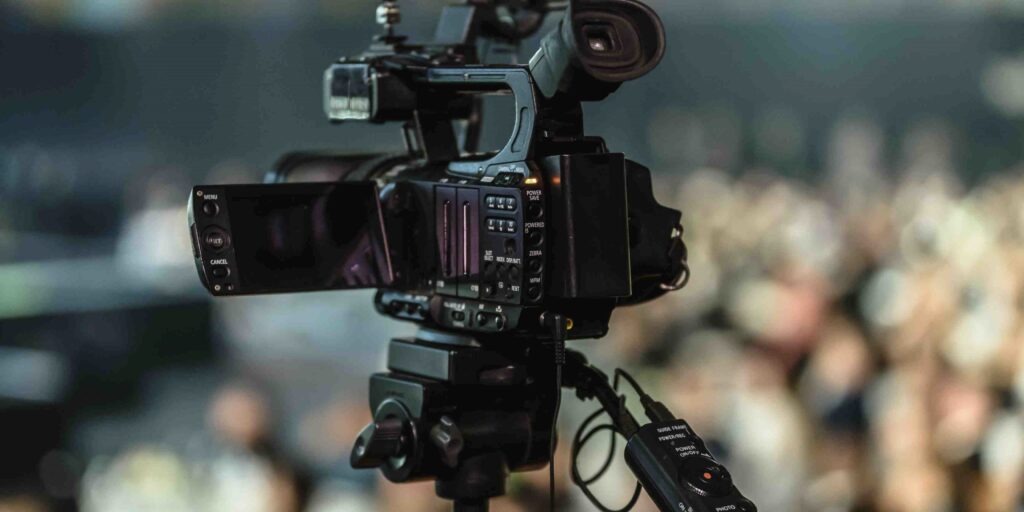Live streaming production is the process of capturing, creating, and streaming live video content over the internet. It has become an increasingly popular way for event organisers to reach a wider audience by broadcasting their events online rather than relying on traditional methods such as radio or television. In Singapore, this type of production has been utilised more frequently in recent years due to its cost-effectiveness and ability to offer a variety of services, such as 3D virtual studio set production. As a result, it has become one of the go-to solutions for those looking to broadcast their events without breaking the bank or spending days setting up complicated equipment.
Benefits of Utilising Professional Live Streaming Services for Events in Singapore

The benefits that come with using professional live streaming services are limitless—they can provide everything from quality video output and audio mixing capabilities to advanced features like green screen technology and remote interviews via Skype. Additionally, these services can help you save money by reducing the setup costs associated with certain types of productions (e.g., multiple camera stream) while allowing you to stream your event directly on platforms such as YouTube or Facebook Live. Furthermore, they offer security measures that ensure your data is safe throughout the entire broadcast process, so no confidential information is leaked or shared without your consent. Finally, live streaming services create professional-looking videos that can be quickly and easily distributed to a variety of different platforms, giving viewers from all around the world access to your event in real time.
Choosing the Right Service Provider for Your Event’s Live Stream
When it comes to selecting a service provider for live streaming production, there are several factors that you should consider. First and foremost is ensuring they have experience producing events in Singapore specifically, as this should ensure a better understanding of local regulations surrounding certain types of productions (e.g., remote interviews). Additionally, pay attention to their portfolio—it’s important that you gauge their capabilities by looking at past projects they’ve worked on and any feedback they may have received from previous clients. Moreover, make sure you understand what type of equipment will be used during the stream as well as whether or not additional features such as green screens or virtual sets will be included (many providers include these in their packages). Finally, always ask about their customer service—ensure that any issues or questions pertaining to the stream are addressed promptly so nothing gets overlooked during setup and broadcasting day.
The 3D Virtual Studio Set Production Process Explained
The 3D virtual studio set production process requires a complex setup of both hardware and software in order to create the illusion of a professional-looking broadcast. First, multiple cameras are used to capture different angles of the scene, while audio mixing is done through specialised equipment such as mixers or preamps. Additionally, effects like fading video transitions can be added by using specialised software that allows you to manipulate each camera’s settings. Furthermore, depending on the scope of your project, you may need additional technologies such as green screens or chroma key backgrounds in order to achieve certain visual effects during live streaming (this would require extra equipment). Finally, post-production editing can also be done in order to adjust any lighting issues or discrepancies between frames if necessary, allowing for more consistent and aesthetically pleasing stream.
Tips for Optimising Your Live-Streamed Event Experience

Live streaming an event requires more than just setting up a few cameras and hitting “record”—there are several steps you can take ahead of time in order to ensure that your live stream is successful. To begin with, make sure your internet connection is reliable so viewers don’t have their experience ruined by buffering issues or poor sound quality. Additionally, plan out what type of content you want to share during the stream and think about how best to present it—this could mean setting up different camera angles, creating visual elements like animations or graphics, and ensuring that whatever audio is playing is mixed properly (so your viewers can actually hear it). Finally, practise makes perfect—it’s important to test out everything before your event so any issues can be identified and resolved.
Making use of advanced technologies to enhance your online viewers’ experience
Advanced technologies such as augmented reality, 360-degree video streaming, virtual sets and 3D graphics, and green screens or chroma key backgrounds can all help add a unique experience for online viewers. Augmented reality allows producers to create an interactive environment in which people can “walk around” inside a virtual space created from real-world elements. Similarly, 360-degree video streaming gives viewers an immersive experience by surrounding them with live action footage from every angle. Virtual sets are pre-created environments that provide realistic backdrops for where the hosts are speaking from, while 3D graphics allow producers to layer text or images over their broadcast in order to explain concepts more effectively. And finally, green screens and chroma key backgrounds enable videographers to swap out different backgrounds on the fly without having to change locations or spend time setting up a new studio.
How to Integrate Social Media with a Live Stream Event
Integrating social media into a live stream event is an excellent way to get more people engaged and talking about the event—particularly since most platforms now have built-in streaming capabilities such as Facebook Live or YouTube Live. To start, make sure you’re actively engaging your audience by encouraging viewers to comment, share their thoughts, ask questions, etc. throughout the broadcast so they feel like they are part of the experience. Additionally, utilise hashtags and other social tools in order to create buzz around your livestream—this can be done before, during, and after the event in order to drive even more attention towards it (and if possible, offer giveaways or discounts for attendees who follow certain steps). Finally, try leveraging influencers by having them join your stream as guest speakers or moderators—this will not only add value but also help you reach a much wider audience.
Using Analytics to Monitor and Measure Engagement During A Livestream Event
Analytics are essential when trying to measure engagement levels during a livestreamed event—they allow producers and organizers to see how many people tuned into the broadcast as well as what types of content resonated most strongly with viewers. To start, you’ll want to keep track of how many people are watching the stream in real-time, as well as what platforms (YouTube, Facebook Live, etc.) they’re using to access it. Additionally, you can use metrics such as comments or likes in order to gain insight into your viewers’ reactions and opinions. Finally, don’t forget about post-broadcast analytics—monitoring things like replay views and total watch time after the event has concluded will give you a better picture of how successful your broadcast was.
Creative Ways to Market Your Singapore Live-Streamed Event
Marketing is essential for any livestream event—after all, what good is hosting one if nobody knows about it? Fortunately, there are a number of creative ways that organizers and producers can spread the word ahead of their broadcast. First and foremost, leverage influencers by having them promote your event on their own channels. Other tactics include creating social media campaigns with eye-catching visuals and strategically placed keywords so potential viewers can easily find out more info; providing viewers with a sneak peek before the actual stream begins via short clips or trailers; engaging current community members and encouraging them to share the broadcast with their friends and followers; utilising paid advertising options such as Facebook Ads or Google AdWords; and finally, hosting giveaways to entice more people to tune in.
Wrapping Up
Live streaming production can provide a cost-effective, efficient way of expanding your event’s reach—whether it be announcing new products, offering press conferences, or even launching an online course. By utilising professional live streaming services in Singapore specifically (along with 3D virtual studio set production), you’ll be able to create an immersive experience for viewers all around the world due to its flexibility and quality output. Furthermore, by using advanced technologies like augmented reality, 360-degree video streaming, green screens, chroma key backgrounds, and 3D graphics during the broadcast itself, you’ll help enhance the overall viewer engagement levels while giving them something unique they can’t find elsewhere. Finally, integrating social media while also leveraging influencers and keeping track of relevant analytics will allow organizers and producers to gain a better understanding of how their livestream performed post-event so they can identify areas that need improvement.
FAQs:
Live streaming production is the process of capturing live video content over the internet for broadcasting purposes. It requires specialised equipment, such as cameras and audio mixers, which are used together with software in order to create the desired effect.
Ensuring your event’s success requires proper planning and execution. Make sure you research different service providers before selecting one and pay attention to their portfolio—it’s important that you gauge their capabilities by looking at past projects they’ve worked on and any feedback they may have received from previous clients. Additionally, practise makes perfect—test out everything before your event so any issues can be identified and resolved.
The benefits of using a professional service include cost savings (since setup costs associated with certain types of productions such as multiple camera stream is lower); improved quality output; advanced features such as green screen technology or remote interviews via Skype; security measures that ensure data is safe throughout the entire broadcast process; access to multiple platforms allowing viewers around the world to watch in real time; post-production editing for consistent visuals and audio; and customer support that ensures quick resolution of any problems encountered during broadcasting day.
3D virtual studio set production requires setting up both hardware (multiple cameras, mixers, preamps) and software in order to create the illusion of a professional broadcast. Additionally, you may need extra equipment, such as green screens or chroma key backgrounds, if you’re looking to add certain visual effects during the live stream. Finally, post-production editing can also be done in order to adjust any lighting issues or discrepancies between frames if necessary.
Advanced technologies like augmented reality, 360-degree video streaming, virtual sets and 3D graphics, and green screens or chroma key backgrounds all help create a unique experience for online viewers. Augmented reality creates an interactive environment from real-world elements, while 360-degree video streaming surrounds them with live action footage from every angle. Virtual sets offer realistic backdrops for where the hosts are speaking from, while 3D graphics allow producers to layer text or images over their broadcast in order to explain concepts more effectively—and finally, green screens and chroma key backgrounds enable videographers to swap out different backgrounds on the fly without having to change locations or spend time setting up a new studio.
Integrating social media into your live stream event is an excellent way to get more people engaged and talking about the event. To start, actively engage your audience by encouraging viewers to comment, share their thoughts, ask questions, etc. throughout the broadcast so they feel like they are part of the experience. Additionally, utilise hashtags and other social tools in order to create buzz around your livestream—this can be done before, during, and after the event in order to drive even more attention towards it (and if possible, offer giveaways or discounts for attendees who follow certain steps). Finally, try leveraging influencers by having them join your stream as guest speakers or moderators—this will not only add value but also help you reach a much wider audience.
Analytics are essential when trying to measure engagement levels during a livestreamed event—they allow producers and organizers to see how many people tuned into the broadcast as well as what types of content resonated most strongly with viewers. To start, you’ll want to keep track of how many people are watching the stream in real-time, as well as what platforms (YouTube Live) they’re using; then, pay attention to metrics like comments or likes in order to gain insight into reactions or opinions from viewers; and finally, don’t forget about post-broadcast analytics—monitoring things like replay views and total watch time will provide a clearer picture of how successful your broadcast was.
Marketing is essential for any livestreamed event—after all, what good is hosting one if nobody knows about it? Leverage influencers by having them promote your event on their own channels; create social media campaigns with eye-catching visuals and strategically placed keywords so potential viewers can easily find out more info; give viewers sneak peeks ahead of the actual stream via short clips or trailers; engage current community members and encourage them to share the broadcast with their friends or followers; utilise paid advertising options such as Facebook Ads or Google AdWords; and host giveaways to entice more people to tune in.
For those looking to save money on their production costs, there are some DIY solutions that could be useful. Platforms such as YouTube Live allow you to stream content from virtually anywhere, given that you have access to an internet connection. Additionally, tools like Open Broadcaster Software (OBS) make it easy for anyone with basic technical knowledge to set up a live stream without needing specialised equipment. However, these options don’t offer the same quality output or advanced features that professional services provide, so depending on your project, you may want to consider investing in one of those instead.
Ensuring your livestreamed event is successful requires proper planning and execution. First and foremost, research different service providers before selecting one. Pay attention to their portfolio—it’s important to gauge capabilities by looking at past projects they’ve worked on and any feedback they may have received from previous clients. Additionally, practise makes perfect—test out everything before your event so any issues can be identified and resolved. Finally, market the broadcast ahead of time by leveraging influencers, creating social media campaigns, providing viewers with sneak peeks via short clips or trailers, engaging current community members, utilising paid advertising options such as Facebook Ads or Google AdWords, and hosting giveaways to entice more people to tune in. Following these steps will help ensure that you put together an entertaining broadcast that viewers enjoy watching.

